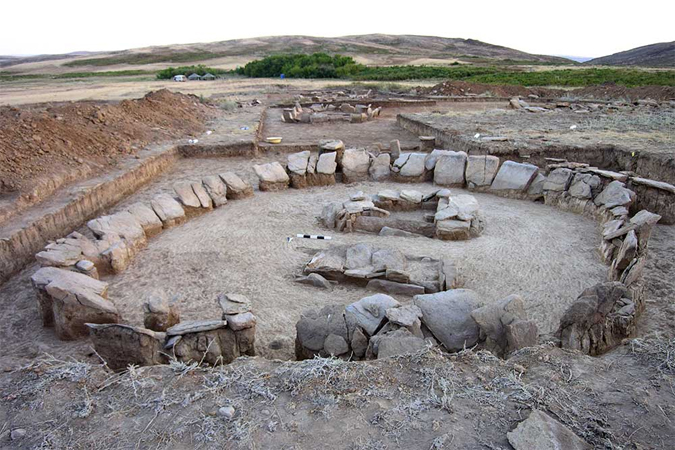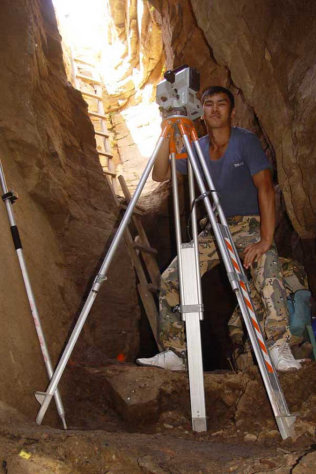Copper and Tin from the Central Asian Steppe
Bronze Age and Early Iron Age Extraction of Raw Materials in Eastern Kazakhstan
Contacts: Prof. Dr. Thomas Stöllner
thomas.stoellner@rub.de
A research project launched in 2003 with the support of the Gerda Henkel Stiftung is concerned with the Bronze Age extraction of copper and tin in eastern Kazakhstan. The ore deposits lie mainly in the Altai Mountains and constitute one of the richest deposits of raw materials in Central Asia. We carried out extensive prospections and excavations in the massif of the Kalba-Narym mountains, and succeeded in finding evidence of copper and tin production in the 3rd and 2nd millennia BC, and gaining a better understanding of the associated settlement landscape. The most sensational discovery was that of the oldest miners’ graves ever found in Central Asia. More recent research has focused on the question of whether tin from Central Asia was used in the Middle East.

Fig. 01: The Askaraly II tin-mining district.
Zone of Cultural Contact between Asia and Europe
The Altai Mountains and the adjoining ridges of the neighbouring mountain ranges contain some of the biggest mineral deposits in Central Asia. They are located in the border region between Kazakhstan, Russia (Siberia), Mongolia and China. The area has always been a zone of cultural contact between Asia and Europe. Various economic factors, such as those resulting from the extraction of metal raw materials or the transhumance of the forest steppe nomads, have had a lasting impact on the cultural development and dynamics of the region. During the snowy winters, the nomads preferred to stay in the valleys of the Altai. Even in historic times, extraction of raw materials was seasonal (in the so-called Chudic mines), and is likely to have led to supra-regional barter networks. Cultural groups from Siberia and Central Asia exploited the mineral deposits of the Altai.Wide-Ranging Insights into tin Mining
Our research in the massif of the Kalba-Narym mountain range gave us wide-ranging insights into tin mining and the way it was organized in the 2nd millennium BC. The Delgebetej was obviously a popular region for settlement and economic activity, and small cemeteries and possibly also settlements were established here.Immediately in front of the tin mines of Askaraly II we came across several graves containing grooved hammerstones – possibly as grave goods or as devotional objects. This makes these the first and oldest miners’ graves in Central Asia.
An associated settlement lies adjacent to this cemetery to the southwest: tin ore, metallurgical remains, tools and ceramics leave no doubt that this is connected with mining and with the cemetery. A rectangular stone building, of the type known as a half pit house (poluzemljanka), could point to a more settled way of life, though the general assumption is that the Andronovo groups had a semi-nomadic subsistence strategy.
Excellent Findings on the Primary Extraction
Traces of mining in the hard surrounding rock offered us excellent findings on the primary extraction carried out by miners. Clearly, two extraction techniques were in use: the miners used stone hammers, and also deployed the technique of fire-setting in some mining areas (Askaraly II), but not in others (Askaraly I). Moreover, two types of spoil heaps point to different phases or technologies. Fire-setting may only have been possible in places where sufficient wood resources were available. This may also be the reason for the establishment of smelting sites along the course of the Schulbinka river (to the north of the Irtysh), whose banks were flanked with floodplain forests. Whether there is a connection, perhaps even an economic cycle based on transhumance, needs to be further clarified by means of excavations and scientific investigations.
Fig. 04: Askaraly II cemetery.
Long-Distance Trade Network
Tin was undoubtedly a supra-regional trade commodity during the 2nd millennium. We are particularly interested in whether tin from Central Asian deposits was used by the advanced civilizations of the Orient. Certainly, in the first half of the 2nd millennium, there were cultural groups – particularly the Andronovo cultural complex, in the form of the Tazabag’jab group – who advanced as far as the Oxus civilization of Central Asia, for instance in the Fergana valley. This clearly gave access to a cultural network which, in terms of cultural history, formed the context for resource-based relationships of all kinds. These could have stretched well into the west, particularly by way of the Eurasian steppe.It is interesting, furthermore, that some bronze objects, both Mesopotamian bronzes and early tin bronzes from Troy, appear to come from geologically ancient deposits. We have found isotope patterns of a similar age in metal finds from east Kazakhstan; perhaps the metal used (copper, tin) comes from this region. This is a further indication that these deposits were part of a long-distance trade network extending far into the west. This gives a further clue to the significance that the geologically ancient Cambrian and Precambrian mountain ranges of Kazakhstan appear to have. Nonetheless, many questions on the trade in raw materials have yet to be answered.


